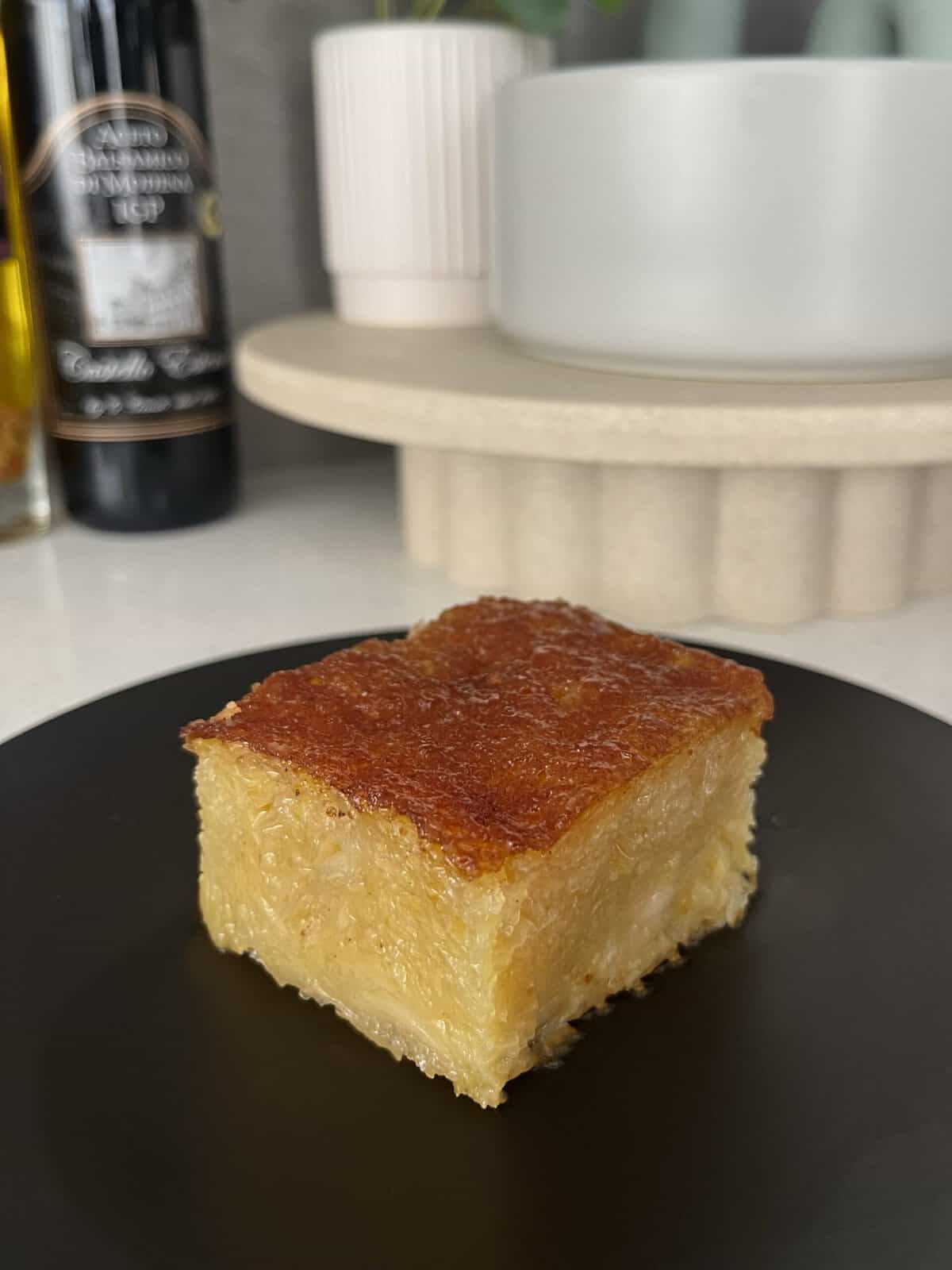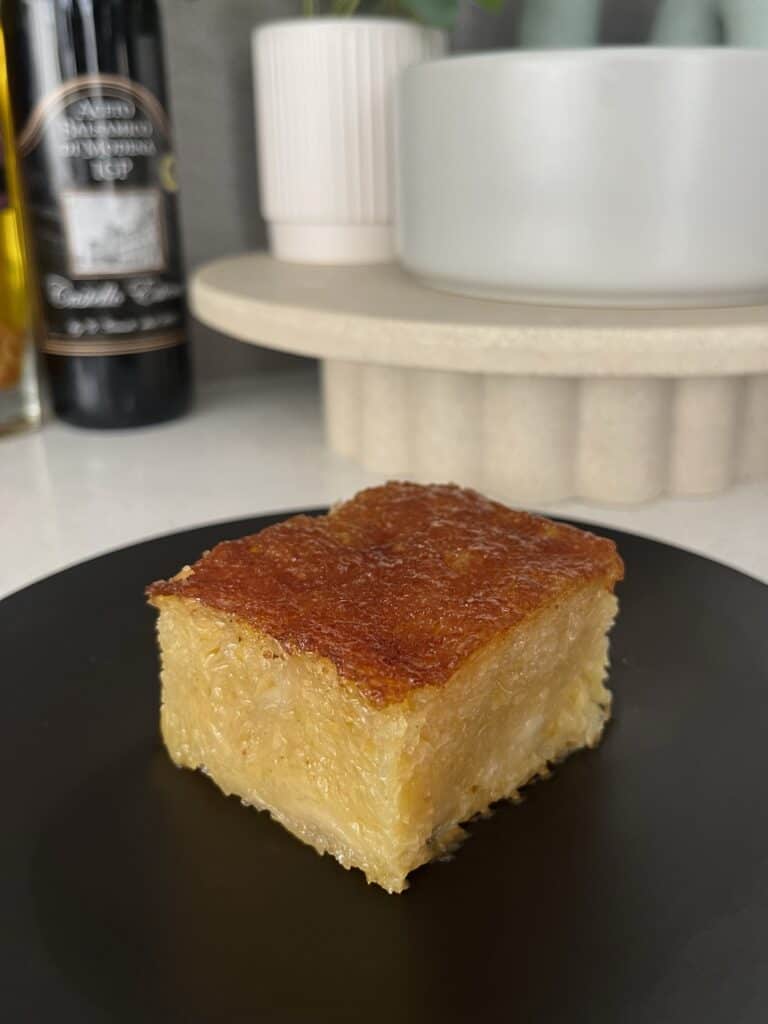Portokalopita is a traditional Greek orange cake that is soaked in a sweet syrup. If you are looking to try baking a cake that is a bit different, then this is definitely a recipe for you. Freshly squeezed oranges in a flourless filo pastry based batter, doused in a lightly spiced cinnamon syrup… divine.
This portokalopita was requested by my partner to be his birthday cake. We first tried it in Santorini, it was a dessert after a delicious meal. Ever since then, it has been on the list to be the birthday boy’s cake! The best way to describe the texture is almost like a crumpet. It is soft and spongy, which allows the cake to soak up all the syrup’s goodness.
Key Ingredients
Cake
- Oranges are used for both their juice and their zest. Some recipes call for store bought orange juice, which is fine if you’re in a pinch, but I recommend going for the fresh stuff!
- Sugar is an important ingredient in almost all baking. It helps the cake maintain its structure, and it is part of the portokalopita’s foundation.
- Canola oil by adding this to the cake, it ensures a moist texture. It means that the cake remains soft, instead of using butter that can harden when cooled. It is important to use a light tasting oil as to not interfere with the flavour.
- Yoghurt also helps keep the portokalopita moist and tender. In this recipe you are going to want to use a natural yoghurt or greek yoghurt. This also means there is the faintest tang that balances out the sweetness of the oranges and syrup.
- Eggs are an important kind of binding ingredient. They’re thicker in texture, and hold the other ingredients together when baking. Eggs stabilise and build volume.
- Baking powder ensures that the cake will rise, and not deflate into a solid goop. This recipe has no flour, only filo pastry, so it needs baking powder to give it a little bit of lift.
- Vanilla paste compliments the other flavours in the portokalopita. Fresh oranges, light cinnamon, and vanilla are an amazing combination. Vanilla paste adds a delicious aromatic note, elevating the overall taste of the cake.
- Filo pastry is what builds the base of the cake. Filo pastry is the flour replacement in the portokalopita, and is what gives the cake its unique charm. The filo pastry absorbs the wet ingredients, and creates the batter consistency. Some recipes recommend baking the pastry in the oven first to completely dry it out. I had no issue with using it straight away – although it had been out of the fridge for quite some time when I made it. If your pastry feels on the damper side, lay it flat in the oven at 200℃ for 15-20 min (keep an eye on it so it does not burn).
Syrup
- Sugar is the base for a sweet syrup. This is what is going to give the syrup its thickness, and help it stick to the cake when soaking.
- Cinnamon stick is infused in the syrup whilst it’s bubbling away. We want a lightly spiced cinnamon flavour, which is why sticks are better than straight cinnamon powder. If you want a strong cinnamon flavour, feel free to go and add more to your preference.
- Water makes sure the syrup keeps its liquid form. The water is what the sugar dissolves into. Plus, it helps the cinnamon stick be able to infuse its flavour properly.
How to make this heavenly Portokalopita
Preparation.
Preheat your oven to 180℃. If using a regular cake tin (not non-stick) now is the time to grease it.
Start the batter.
In a large mixing bowl combine the sugar, canola oil, vanilla paste, and eggs. Mix until combined. Now pour in the orange juice, and add the zest as well. Mix.
Shred the filo pastry.
Roll the filo pastry up and vertically slice into strips, then horizontally slice again. This is to create small pieces, you could also use your hands to rip it up. Fold the shredded filo pastry into the wet mix. Then add the baking powder too.
Bake the portokalopita.
Pour the cake batter into a greased or non-stick baking tin. I used a rectangle shaped tin. Bake for 45 minutes. Use a skewer to poke the cake, if it comes out mostly clean then the portokalopita is ready, if not add cake back into the oven for another 5-8 minutes.
Make the cinnamon syrup.
While the cake is baking, it is the perfect time to make the syrup. First add the sugar, water and cinnamon to a pot. Bring a rolling boil, stirring continuously, until sugar has completely dissolved. Take the syrup off the stove, let sit until cool.
Soak the portokalopita in the syrup.
When the cake is ready, remove from the oven and poke lots of holes throughout the cake. Pour the syrup onto the cake, and let sit so the syrup sinks in.
Serves up!
Place the portokalopita in the fridge for an hour or so before serving. Serve with vanilla ice cream or yoghurt, and enjoy!
Storage
This portokalopita is definitely on the sweeter side! Which means you are more likely to serve it in smaller portions. Due to the portokalopita having fresh orange juice in it, it needs to be kept in the fridge – which is convenient as the cake is meant to be served cold anyway! This cake can keep for up to 5 days in the fridge. It is not recommended to freeze the portokalopita due to the filo pastry, which would become soggy and lose its spongy texture.
What to serve with the Portokalopita
Personally, I think this cake is best served with vanilla ice cream! The ice cream blends in so well and helps balance out the sweetness from the syrupy cake. Greek yoghurt could be another alternative.
More for your sweet tooth:
Alrighty, you should now have everything you need to know to make this divine portokalopita! Take a trip to the Mediterranean with this traditional Greek orange cake. Come on, let’s get to baking a heavenly cake.

Portokalopita (Greek Orange Cake)
Ingredients
Cake
- Juice of 3 oranges
- Zest of 2 oranges
- 270 g sugar
- 300 ml canola oil
- 200 g natural yoghurt
- 3 eggs 2 if large
- 2 tsp baking powder
- 2 tsp vanilla paste
- 400 g filo pastry
Syrup
- 2 cup sugar
- 1.5 cup water
- 1 cinnamon stick
Instructions
Cake
- Preheat your oven to 180℃.
- In a large mixing bowl combine the sugar, canola oil, vanilla paste, and eggs. Mix until combined.
- Now pour in the orange juice, and add the zest as well. Mix.
- Roll the filo pastry up and vertically slice into strips, then horizontally slice again. This is to create small pieces, you could also use your hands to rip it up.
- Fold the shredded filo pastry into the wet mix. Then add the baking powder too.
- Pour the cake batter into a greased or non-stick baking tin. I used a rectangle shaped tin.
- Bake for 45 minutes. Use a skewer to poke the cake, if it comes out mostly clean then the portokalopita is ready, if not add cake back into the oven for another 5-8 minutes.
- When the cake is ready, remove from the oven and poke lots of holes throughout the cake. Pour the syrup onto the cake, and let sit so the syrup sinks in.
- Place the portokalopita in the fridge for an hour or so before serving. Serve with vanilla ice cream or yoghurt, and enjoy!
Syrup
- While the cake is baking, it is the perfect time to make the syrup. First add the sugar, water and cinnamon to a pot.
- Bring a rolling boil, stirring continuously, until sugar has completely dissolved.
- Take the syrup off the stove, let sit until cool.


